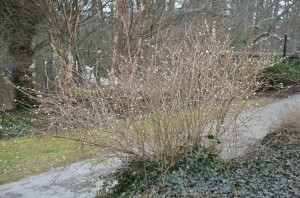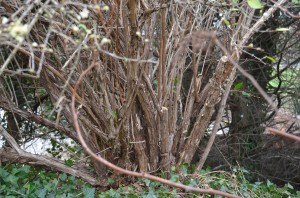Fragrant honeysuckle (Lonicera fragrantissima) has creamy white flowers which open in January during a brief warm-ups and continues, off and on, through February and March in the Southern Appalachian region (USDA hardiness zones 6 and 7). It is an old heirloom shrub indigenous of China. It’s hardy in USDA hardiness zones 4-8.
Fragrant honeysuckle is beloved for its lemony floral scent in the winter. Gardeners cooped up in their homes may force cut boughs indoors. It typically grows 8-10 feet tall and wide, although taller unkempt shrubs are easy to find in old landscapes in the South.
Rounded shaped leaves are 1-3 inches long and tend to hang into late fall with little significant color change. The 1/4 inch green berries ripen dark red in late May and the dark bluish-green spring foliage hide most of them. The bark sheds off in narrow strips.
Fragrant honeysuckle asks for little care and grows in adequately drained average soil. This shrub should be pruned annually from late winter or spring after most flowering is completed. Disease and pest problems are rarely an issue.
Fragrant honeysuckle can be utilized as a low cost deciduous privacy screen. Old plants may be cutback to a few inches above ground with a chainsaw, (called “renewal pruning”), and fed 2-3 handfuls of 10-10-10 granular fertilizer broadcast at least 6-12 inches away from the shrub base.
Information from Mr. John Elsley, South Carolina plantsman: ‘Winter Beauty’ (L. purpusii ‘Winter Beauty’) is a showier winter flowering selection of fragrant honeysuckle. It is a hybrid cross between L. fragrantissima x L. standishii, and has been listed in Hillier Nursery catalog in England. Its winter blooming creamy white flowers are slightly larger and highly fragrant.
Regarding possible invasive issues, fragrant honeysuckle blooms very early when most insect pollinators are not active. Seedlings are rarely found growing around shrubs.



 Posted in
Posted in 
